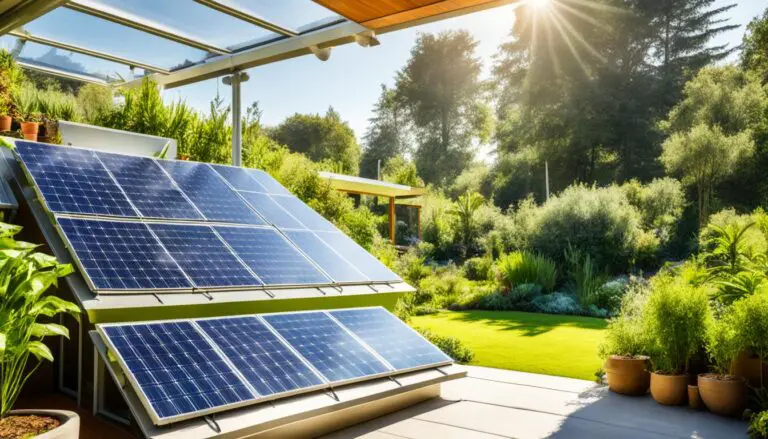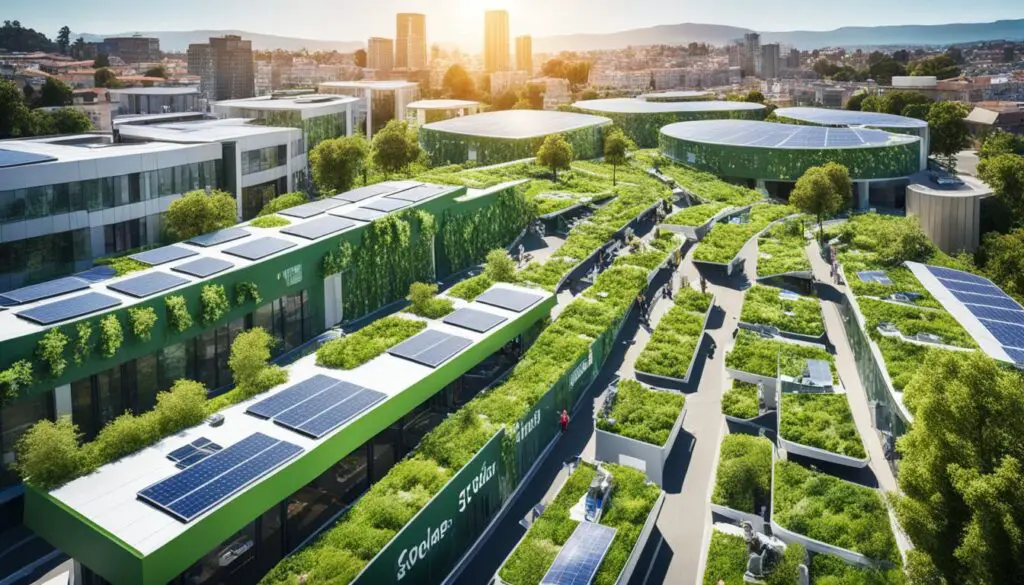Welcome to the exciting world of smart eco homes. Here, sustainability joins hands with advanced technology for a greener future. Let me guide you through the innovations defining our living spaces and guarding our planet.
Smart eco homes shine with energy-saving lighting. LED bulbs, crucial in smart lighting, use 75% less energy than old bulbs. They save loads of energy, lower carbon emissions, and last longer.
Adopting LED lighting widely could save a huge amount of electricity by 2027. This means over $30 billion in savings. Think about the great impact this could have on both our environment and economy.
Smart thermostats are key in managing home climates efficiently. Devices like the Google Nest allow homeowners to use energy wisely. They can even control the temperature from afar. This way, we enjoy comfort without wasting resources.
Window treatments are also vital in smart eco homes. They use tech to control sunlight, enhancing privacy and saving energy. Thus, they contribute significantly to sustainable living.
The future holds more innovative solutions for eco homes. Home batteries and micro-grid systems will change how we use renewable energy. These advancements will make green living even more attainable.
It’s best to have professionals install these smart technologies. Experts ensure they work perfectly and are easy to use. This way, homeowners get the most benefit while avoiding the hassles of doing it themselves.
Key Takeaways:
- LED bulbs are crucial for energy efficiency in smart eco homes, consuming 75% less energy than incandescent bulbs.
- Smart lighting control systems, like Lutron Caséta and Lutron HomeWorks, offer advanced features such as dimming and integration with other smart devices.
- Smart thermostats, like the Google Nest and Savant Multistat, optimize energy usage and climate control, reducing waste.
- Automated window treatments regulate sunlight and improve energy efficiency in smart eco homes.
- The future of eco homes includes home batteries, micro-grid systems, and other energy optimization solutions.
The Rise of Smart Cities: Transforming Urban Living
Smart cities are a big help in solving the issues with sustainable living and city planning. These places use new tech to focus on being efficient, cutting down waste, and making life better for people who live there.
In the area of transportation, smart cities shine. They use smart transportation systems and electric cars to cut down traffic jams and carbon emissions. Adding smart tech to transportation is key to creating greener, smarter cities.
Smart cities are also big on saving energy. They use smart grids and renewable energy to use less energy and create less waste. By choosing sustainable energy, they cut down the pollution from old energy methods and look forward to a greener future.
In smart cities, waste management is getting smarter too. They use recycling tech and smart bins to turn trash into something useful. This helps create a cycle where less waste harms our planet.
Water saving is essential in smart cities. They use tech to make sure water is used wisely and saved. Smart sensors and AI help keep an eye on water and make its use more sustainable.
Plus, smart cities make sure everyone gets to have a say. They use education and feedback online to involve people in decisions. This way, everyone’s voice helps make the community better.
Advantages of Smart Cities:
- Efficient transportation systems reduce congestion and carbon emissions.
- Energy-efficient infrastructure optimizes energy usage and reduces waste.
- Innovative waste management solutions transform waste into resources.
- Water conservation systems promote efficient usage and conservation.
- Community engagement fosters a sense of belonging and ownership.
Smart cities mix tech with caring for the needs and well-being of people. They lead the way to a future that’s greener, works better, and helps city communities thrive around the world.
Breakthroughs in Renewable Energy: Paving the Way to a Sustainable Future
Renewable energy is key in fighting climate change and saving resources. New solar panels, called perovskite cells, catch more sunlight. They make solar power a main energy source. Floating solar farms use water to help panels work better and save water too.
Wind farms in the ocean catch strong, steady winds. This helps make clean energy.
Eco-friendly building materials lower carbon output and save resources. Building green homes costs less with local materials and smart methods. People want these eco homes for their benefits. These homes lower energy bills, improve air inside, and need less upkeep.
Building practices must change to help the planet and save resources. A high-rise in Utrecht shows how with its gardens and greenhouses. Eco homes are efficient, using renewable and local materials.
They’re made with parts built ahead of time. This lessens harm to the environment. It leads to less carbon in the air and less waste.


